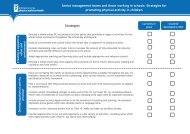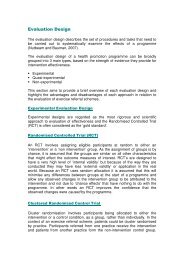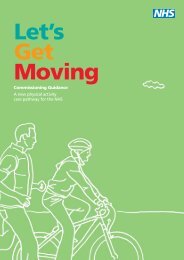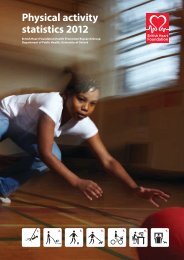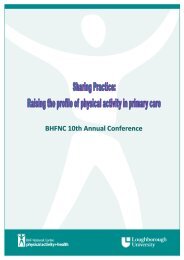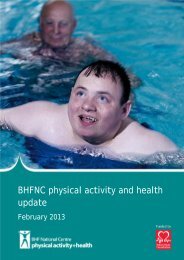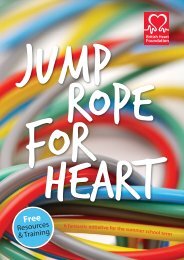5 Practical ideas for physically active play - BHF National Centre ...
5 Practical ideas for physically active play - BHF National Centre ...
5 Practical ideas for physically active play - BHF National Centre ...
- No tags were found...
Create successful ePaper yourself
Turn your PDF publications into a flip-book with our unique Google optimized e-Paper software.
Tightrope walking– Set up two parallel ropes on the floor aboutone metre apart.– Ask the children to walk heel to toes betweenthe two ropes without stepping on the ropes.– Gradually bring the ropes closer togetherto make it harder.– Ask them to repeat the activity trying to keepa beanbag on their heads.– Repeat the activities walking along tile lines,wooden floor/laminate lines or a chalked lineor length of tape. Get them to try different waysof moving along the line and staying on it, eg,lifting their knees higher, walking backwards,taking big strides.– Let the children walk along benches, if youhave them. Some children may need or wantyour support until they feel more confident.Support them as they walk along other lowraised surfaces, eg, walls, trim trails and climbingequipment in parks.Tug-of-war– Use an old sheet or piece of lycra and letchildren pull on it on both sides.Equipment to encourage bouncing andjumping– Trampettes or trampolines– French elastic– Space hoppers– Skipping ropes– Mini hurdlesBall activitiesRolling and retrieving a ball– Ask children to select from a variety of balls,to roll, chase after, collect and return themto the original spot.– Sit them in pairs (straight backs) with legs apartand roll a ball to each other, grasp it and returnit to their partner.– Sit them in pairs with legs crossed (straightbacks) and repeat the activity. Children needto be more accurate with their rolling now.– Can they find another position to roll from,eg, kneeling, one-leg kneel, squatting,crawling position?Trapping a ball– Ask the children to stand fairly close togetherin pairs. One child rolls or kicks a large ball tothe other, who aims to stop the ball by bendingtheir knee down toward and over the ball.– Next, ask them to trap the ball with their footbe<strong>for</strong>e returning it. As they improve, increasethe distance between them.Guided discovery ball activities– Set out a variety of balls of different shapes,sizes and textures and ask children to pick one.– Ask them to find different ways of making theirball move (by rolling, throwing, kicking, pushingwith a part of their bodies, using anotherimplement to push it along). For more <strong>ideas</strong> on guided discovery sessions seeSection 6, page 11.Section 5 – <strong>Practical</strong> <strong>ideas</strong> <strong>for</strong> <strong>physically</strong> <strong>active</strong> <strong>play</strong>73



